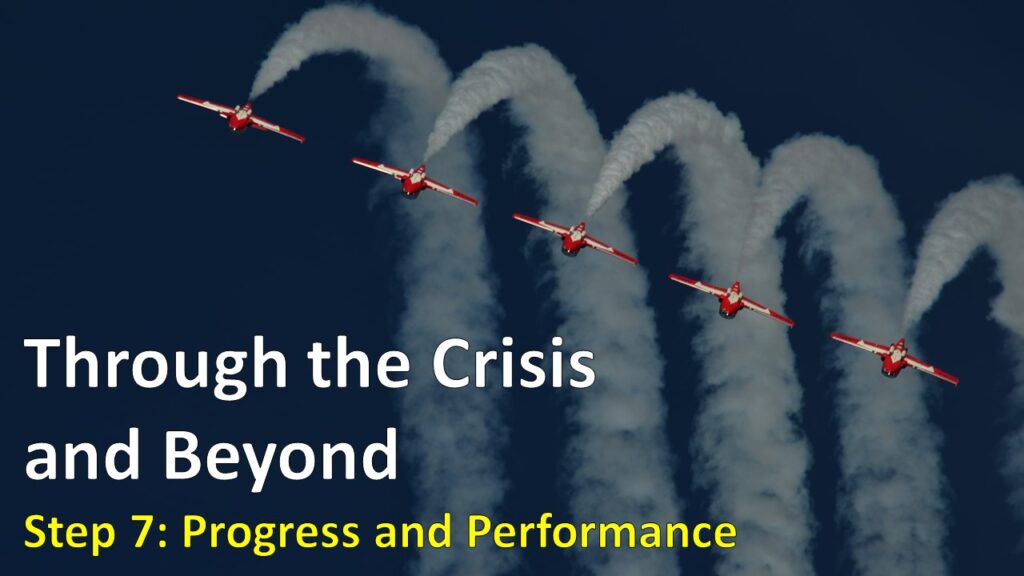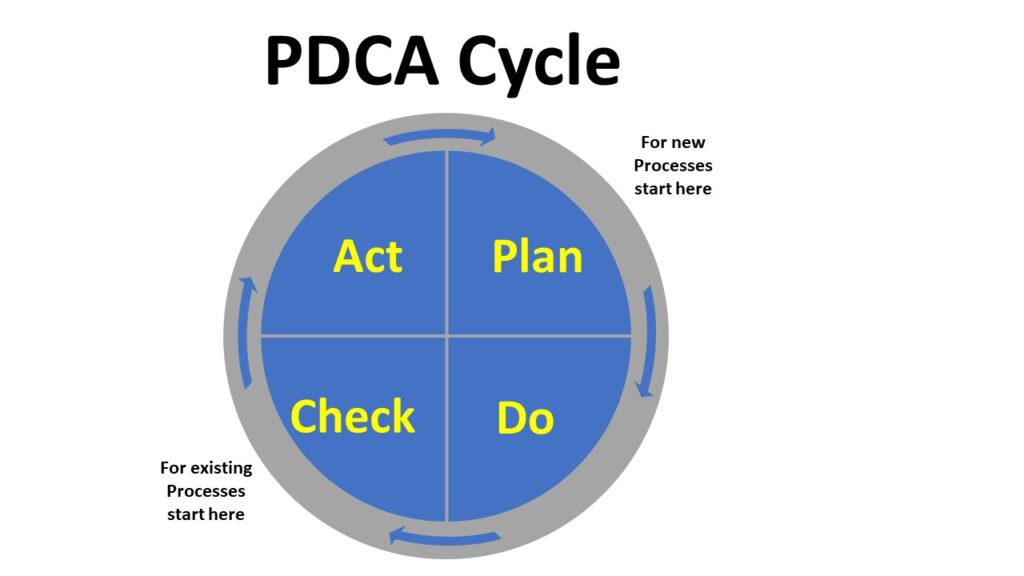This is the seventh in a series of articles designed to help you lead through the current COVID-19 crisis AND thrive on the other side.

In the last article we covered the importance of Processes.
In this article we answer the question of what makes world-class organizations world-class by looking at Progress and Performance.
If the pandemic has or will cause changes in the way your organization works, read on. There are two main points about improvement that you’ll want to bring into your culture, or strengthen if they are already there.
As always, if you’re short on time, key takeaways and actions are listed at the end. Let’s continue…
Progress
Ever wonder what makes world-class organizations world-class? There are two parts. Both deceptively simple. The first part is:
World-class organizations never stop improving.
That’s it. It’s not sexy. It’s not going to make headlines. But it is the proven path to becoming excellent at what you do.
This is true for individuals and organizations and parts of organizations. Those who continually make step-by-step Progress toward what is important to their Mission are the ones that reach excellence.
James Clear talks about this in his book, Atomic Habits. He calls it ‘Aggregation of Marginal Gains.’ He even shares a mathematical depiction of this concept. A 1% gain each day for a year will take you from 1.0 (where you are right now) to 37.78. And a 1% decline every day for a year will take you from 1.0 to 0.03. see: https://jamesclear.com/marginal-gains
“But what about all those ‘Eureka!’ moments we read about? Or overnight successes?” Go back and read again. Almost without exception, those moments come after years of practice or a persistent series of failed attempts followed by that one breakthrough. Each attempt added to the knowledge base of what to do and what not to do. The sum of all that experience and knowledge is what led to the success.
When President Kennedy said we were going to send a man to the moon and bring him back safely, NASA didn’t just go out to the Cape, build a big moon rocket, and blast it off. That was too big of a step. First, there were unmanned flights. Then single-pilot sub-orbital Mercury flights. Then John Glen orbited the earth. Later there were larger rockets with two-man Gemini space capsules. Then 3-man Apollo capsules went to the moon and around it. You get the idea. All along the way, NASA practiced maneuvers and techniques that would be needed to get to the moon. Step-by-step they learned the lessons that would lead to Neil Armstrong proclaiming those famous words, “Houston, the Eagle has landed.”
Note the intentionality. It’s not a random walk toward excellence. It is an intentional step-by-step effort.
The Starting Point
So, where do we start this effort? Again, a deceptively simple answer: You can only start from where you are today.
Look at your organization through the lens of your Vision and Mission. Where are you not meeting your Mission or not making progress toward your Vision? Now, narrow down from there. Ask, where are you least meeting your customers’ key requirements? Where are you getting the most employee or customer complaints? What is frustrating to you or your organization? Answers to all of these types of questions will lead you to fertile ground for improvements. To manage those improvement projects, you will need to follow an iterative, step-by-step process.
The PDCA Cycle
The Plan-Do-Check-Act (PDCA) cycle is one of the most useful and powerful methodologies for managing improvements. You instinctively use his methodology all the time. For example, if you are going to take a bath or shower, you: Plan to get clean; Start the water flowing; Check the water temperature before getting in; and Act to adjust the temperature, if needed, and then get in. Once you determine what you want to improve, follow the PDCA cycle:
Plan: Set a plan to improve.
Do: Put the Plan into action.
Check: Ask whether the action achieved the desired result?
Act: If yes, keep working the Plan. If no, adjust the Plan or create a new Plan, and keep going around the cycle. When you have reached your goal, Act to standardize the new process and apply what you have learned to other parts of the organization where it makes sense.

For new projects or processes, you start with the Plan step (PDCA). For existing processes, you start with the Check step (CAP-Do). Both work the same way, just with a different starting point.
Coaching notes:
First, don’t attempt too many improvements in the same area at the same time. This is a prescription for failure. There’s an old saying, “The hunter who chases two rabbits, catches neither one.” In other words, you risk losing focus and overwhelming your resources by taking on too much, even with all good intentions. What would you rather have at the end of a year’s efforts:
A. 100 things done 3%; or
B. 3 things done 100%?
Probably the latter. Counterintuitively, you will end up making more Progress by taking on fewer projects.
Second, there’s a saying among race drivers, ‘Sometimes you have to slow down to go fast.’ That means to change direction (navigating a turn) you have to slow down to make it all the way through the turn smoothly and safely and set yourself up for the next turn. Give yourself and your team permission to slow down and finish each improvement project before tackling the next one.
With all that said about making Progress, if you want to be world-class in everything that is important to your Mission, there’s one more part. And this part may just be more important than the first part.
Performance
Both parts to making world-class organizations world-class are deceptively simple. The first part is: They never stop improving. The second part is:
World-class organizations sustain their improvements.
Again, it’s not exciting, not sexy, but it is the proven path to becoming – and staying – excellent at what you do. You want to sustain what you’ve put in place or you will have wasted all the time, energy, and expense you invested.
Have you ever said something like, ‘Didn’t we fix that last year?’ Or, ‘I thought we changed that process.’ Or, ‘I remember helping work on this two years ago.’ If you’ve had any of these déjà vu moments, you have made changes that you haven’t sustained.
Ensure you sustain your improvements by making the change irreversible. For example, if you are a manufacturer and are having a problem with a part failing, you change the part. The way to make that change irreversible is to remove all of the old parts from your facility and your ordering system so only the new part can be sourced and used from then on.
Key takeaways
First: World-class organizations never stop improving.
Second: Your starting point for improvement is where you are today.
Third: Step-by-step incremental improvement will beat any attempts at a giant leap.
Fourth: You will make more Progress by taking on fewer projects.
Fifth: World-class organizations sustain their changes.
Questions to ask yourself:
- Of all the people and/or organizations that I know that would be considered world-class, how did they get there? Single giant leap or continuous improvement?
- Do we have a continuous improvement culture or a just-enough-to-get-by culture? What changes do we need to make to have a continuous improvement culture?
- Which improvements have we sustained in our organization? What made them sustainable?
- Bonus: What processes can we improve at home (without hindering someone else’s processes!)?
Steps to take:
- Leaders determine the culture of an organization. If you do not have a continuous improvement culture, change your leadership. The pandemic has provided an inflection point in all organizations. Take advantage of this to re-set your culture toward continuous improvement and excellence.
- This pandemic has likely pointed out specific areas that could be improved in your personal work habits. Identify the top one or two and begin improving them using the PDCA model as your guide.
- This pandemic has likely pointed out specific areas that could be improved in your organization’s product and service delivery. Identify the top one or two and lead the effort at improving them using the PDCA model as your guide.
- Bonus: Improve one of your Processes in or around your home to the benefit of everyone, not just yourself.
4 Comments
sikis izle · November 13, 2020 at 12:21 am
If you want to use the photo it would also be good to check with the artist beforehand in case it is subject to copyright. Best wishes. Aaren Reggis Sela
jonesdm8 · November 17, 2020 at 3:55 pm
Thanks for your interest. I am the author and photographer.
erotik · November 14, 2020 at 12:48 pm
Really appreciate you sharing this article post. Thanks Again. Want more. Adela Mace Graner
sikis izle · November 16, 2020 at 8:20 am
I quite like reading an article that can make people think. Estell Cozmo Mina
Comments are closed.